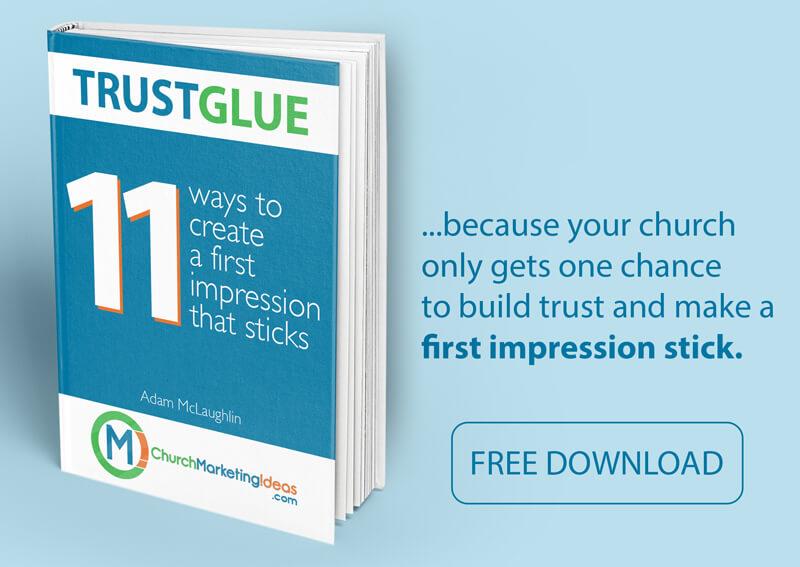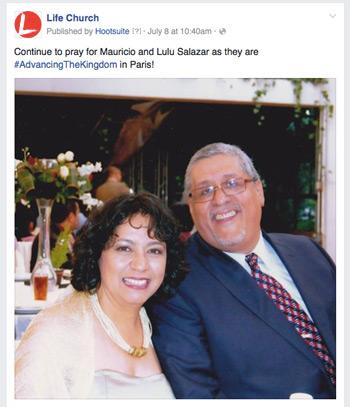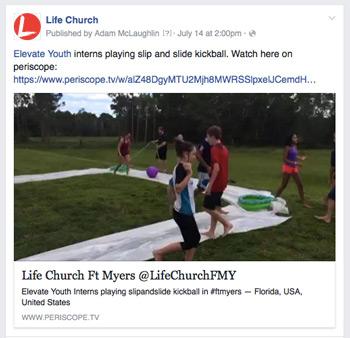The term ‘digital signage’ is just a smart way of talking about the screens that are used to show content, from adverts in stores, through to weather and news in office lobbies. In churches, many are looking to invest in digital signage solutions that can be used to inform, entertain and share information.
You may already have a few screens around your church, but perhaps you’ve not been sure what to put on them. Or maybe you’re thinking of investing in new screens, in order to give your church a digital uplift.
Either way, it’s important to focus firstly on what they can do for your marketing.
Great marketing transmits the values of your brand and helps visitors to absorb them, often without them even realizing. |
Tweet This: |
Here are five ways you can use digital signage within your church to aid and help share your marketing:
1. Showcase new campaigns
The reason most marketing campaigns lose velocity is because they don’t reach enough of an audience. When you create a new marketing campaign, it can be difficult to subtly drop it into a service, around the important notices, information and events that you need to discuss. This is where screens come in. Digital signage screens fill the gaps usually left redundant.
While visitors are waiting for a service they can read all about your new initiatives. As they leave, they can scan for the next event or session they want to attend.
2. Create community
Your church visitors are your biggest brand advocates. Chances are, they’re spreading the word through online communities even when you don’t know about it. Digital signage pulls together the voices of your community into one place. Through screens that show social media feeds such as Twitter, Facebook and Instagram, or create rich social media dashboards. Social media helps your church extend its reach right outside of the doors and into the minds and homes of a much wider audience than physical activity alone.
Screens are a great way to show off your social channels, encourage more of your audience to use them and to create content in an invigorating display.
3. Tell stories

A simple iPhone can now be used as a video recorder, helping you to film testimonials, clips and activities within your church to share on screen. Take images and upload them in a series to your social channels, documenting a project over a series of weeks.
Digital screens take snippets of your message and bookend them into one comprehensive story.
4. Set up advertising
Allow your patrons to advertize on your digital screens to share skills and news with other visitors. Use the screens for your own advertising, allowing you to promote new training sessions, services and your most creative campaigns. You can also add your logo to each slide or image advertising a service or incentive, allowing you to become more memorable in the minds of your visitors.
Advertising on screens is natural, having been used in television and now the internet across desktop and mobile too. This makes it a key channel from which you can work out your message and share it with your audience – who will be ready and waiting to pay attention.
5. Go digital
For churches who struggle to attract younger visitors, digitizing your offering helps to transmit information in a new format. Not everyone who visits your church wants to read lyrics from a print-out or scriptures from a book. For whatever reason (or even just the generational one) some will feel more comfortable accessing information on screen than they will in print.
The screens can be the first welcomer to a younger audience, allowing them to get a feel for your marketing and who you are without necessarily having to have human contact. Ideally, it’s people who make up your church, but letting the screens say hello first, in order to welcome and make younger audiences feel at ease, can help lead the way to new relationships.
(Post photos courtesy of Faith Community Bible Church & ScreenCloud – Thank you!)
Remember, these ideas are just a jumping point. Once you start you can incorporate feedback from your visitors to find out what works and what they want to see. Each church is different, but by working out a digital signage marketing strategy and going for it, you’ll be able to learn and reiterate quickly.
 About the Author:
About the Author:
Mark McDermott is Co-Founder of Digital Product Studio Codegent whose passion is to build world-class digital products. Mark is also CEO of ScreenCloud and spends much of his time empowering individuals to get their underused screens full of beautiful digital content.
Contact Mark on hello@screen.cloud or on Twitter @mr_mcd





 We’ve all had those moments when we have a creative block. You know there’s a graphic to create, a bulletin to design, a website layout just waiting to jump off the screen, but at the moment, you’re having a creative block.
We’ve all had those moments when we have a creative block. You know there’s a graphic to create, a bulletin to design, a website layout just waiting to jump off the screen, but at the moment, you’re having a creative block.
 Every church has unique qualities, requirements, and assignments. Even though some churches may share similarities (like location, attendance, budget or staff size) it’s clear that each is unique, which means your job description will probably be unique to your church.
Every church has unique qualities, requirements, and assignments. Even though some churches may share similarities (like location, attendance, budget or staff size) it’s clear that each is unique, which means your job description will probably be unique to your church.
 What is your pay?
What is your pay? What is the big picture?
What is the big picture?



 Are we aiming to provide information to our current members, or is the goal of our Social Media to reach and invite new people? This will help identify the content and the network you’d like to focus on. Start by considering the target audience of your church. If you’re not yet sure about that, here is a way to
Are we aiming to provide information to our current members, or is the goal of our Social Media to reach and invite new people? This will help identify the content and the network you’d like to focus on. Start by considering the target audience of your church. If you’re not yet sure about that, here is a way to  There is no shortage of Social Media networks and opportunities to spend time online. Refer back to your target audience. It’s easier to get out in the community on twitter (you can follow local organizations and comment on their tweets) or snapchat and it’s easier to provide information on Instagram of Facebook.
There is no shortage of Social Media networks and opportunities to spend time online. Refer back to your target audience. It’s easier to get out in the community on twitter (you can follow local organizations and comment on their tweets) or snapchat and it’s easier to provide information on Instagram of Facebook. What kind of community do you want to build, and how do you want to build it? Does your leadership want you to create an opportunity for people to take a strong stance or keep the waters calm? Will I post about the church’s stance on current issues, or do I stick to promoting upcoming events and ministries?
What kind of community do you want to build, and how do you want to build it? Does your leadership want you to create an opportunity for people to take a strong stance or keep the waters calm? Will I post about the church’s stance on current issues, or do I stick to promoting upcoming events and ministries? The answer could be “Yes, always…” or it may be “Yes, for now…” or maybe “no, just go for it and we’ll discuss as we go.” but as the person posting, don’t take it personal if it’s decided that your posts go through a second set of eyes before they go live. This helps you get an idea of what’s expected and how your ideas for advertising the church on Social Media represent the branding and marketing of your church.
The answer could be “Yes, always…” or it may be “Yes, for now…” or maybe “no, just go for it and we’ll discuss as we go.” but as the person posting, don’t take it personal if it’s decided that your posts go through a second set of eyes before they go live. This helps you get an idea of what’s expected and how your ideas for advertising the church on Social Media represent the branding and marketing of your church. Set the expectation and find out up front. Don’t submit once a week posts if your leader is hoping for daily posts. Don’t commit to daily posts on 4 networks if you’re a volunteer who can only commit to once a day. Have a discussion about what you’re capable of committing to and how close that comes to the expectations.
Set the expectation and find out up front. Don’t submit once a week posts if your leader is hoping for daily posts. Don’t commit to daily posts on 4 networks if you’re a volunteer who can only commit to once a day. Have a discussion about what you’re capable of committing to and how close that comes to the expectations. If another department in the church wants to have their own page (like kids or youth) who is ultimately responsible for their content? Who approves their posting, and do you have a minimum standard you want to maintain for content, image or video quality, etc?
If another department in the church wants to have their own page (like kids or youth) who is ultimately responsible for their content? Who approves their posting, and do you have a minimum standard you want to maintain for content, image or video quality, etc? My personal opinion is as much as possible to address a negative comment in a positive way… “We’re sorry your experience didn’t match our values. We would be happy to discuss a resolution if you’d call the office and ask to speak with…” but some times when a comment is vulgar or contains profanity, it’s clear that a phone conversation isn’t going to address the concern. In that case, I would just delete the comment. If the person persists, block them from your account. It’s not going to change their mind, and if they truly wish to make restitution, they’ll reach out in person – blocking them form Social Media probably won’t affect their change of heart.
My personal opinion is as much as possible to address a negative comment in a positive way… “We’re sorry your experience didn’t match our values. We would be happy to discuss a resolution if you’d call the office and ask to speak with…” but some times when a comment is vulgar or contains profanity, it’s clear that a phone conversation isn’t going to address the concern. In that case, I would just delete the comment. If the person persists, block them from your account. It’s not going to change their mind, and if they truly wish to make restitution, they’ll reach out in person – blocking them form Social Media probably won’t affect their change of heart. Quantifiable like ‘How many likes?’ or ‘How many followers?’ or ‘How Many interactions: comments or shares?’ not things like ‘To spread the Gospel’ or ‘To keep people informed’. Quantifiable goals allow you to discover what’s working, and what could change. The success of unquantifiable goals are a matter of opinion.
Quantifiable like ‘How many likes?’ or ‘How many followers?’ or ‘How Many interactions: comments or shares?’ not things like ‘To spread the Gospel’ or ‘To keep people informed’. Quantifiable goals allow you to discover what’s working, and what could change. The success of unquantifiable goals are a matter of opinion. There may be a great video on youtube that matches up with your current series topic or a funny quote from a famous preacher. What is the balance between finding other content and generating our own?
There may be a great video on youtube that matches up with your current series topic or a funny quote from a famous preacher. What is the balance between finding other content and generating our own? Specifically. Is there someone who is popular on Social Media but doesn’t line up with our beliefs? Is there something that could become a distraction from our goals? Do we address prayer requests in the church with permission, or is this not the forum?
Specifically. Is there someone who is popular on Social Media but doesn’t line up with our beliefs? Is there something that could become a distraction from our goals? Do we address prayer requests in the church with permission, or is this not the forum?
 I get frustrated in a situation when I can’t contribute my best because the parameters aren’t clear, and when it comes to our creative meetings, our team has found some really effective ways to maximize our productivity and effectiveness in a short amount of time – the reason: we’ve all agree to play by the rules.
I get frustrated in a situation when I can’t contribute my best because the parameters aren’t clear, and when it comes to our creative meetings, our team has found some really effective ways to maximize our productivity and effectiveness in a short amount of time – the reason: we’ve all agree to play by the rules. I find it odd that we used to talk about when the meeting would start, but not have a clear plan about when the meeting would end. Based on inviting the right people and having an agenda, take a guess at how long the meeting will be and set an end time… this way people can schedule their next appointment or goals and tasks for the day after that meeting.
I find it odd that we used to talk about when the meeting would start, but not have a clear plan about when the meeting would end. Based on inviting the right people and having an agenda, take a guess at how long the meeting will be and set an end time… this way people can schedule their next appointment or goals and tasks for the day after that meeting. If you’re not sure of what the play is, don’t leave the huddle. This is each team member’s opportunity to clarify the action, the responsibility and the “by when”. If anyone is unsure on the motive, the big picture, the small details, the timeline, the key players or what’s expected of them, this is the time to ask.
If you’re not sure of what the play is, don’t leave the huddle. This is each team member’s opportunity to clarify the action, the responsibility and the “by when”. If anyone is unsure on the motive, the big picture, the small details, the timeline, the key players or what’s expected of them, this is the time to ask.


 Share a recent picture or Facebook post from a missionary. Ask viewers to take a moment and pray for their ministry.
Share a recent picture or Facebook post from a missionary. Ask viewers to take a moment and pray for their ministry. Share a post from one of the other social media channels in your church (kids/youth/small groups)
Share a post from one of the other social media channels in your church (kids/youth/small groups)